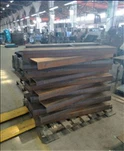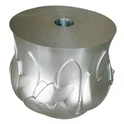Can a brake press be used for bending nickel alloys? That's a question I often get from folks in the metalworking industry. As a brake press supplier, I've seen firsthand the versatility of these machines, but when it comes to nickel alloys, there are some important factors to consider.
First off, let's talk about what a brake press is. It's a machine that uses a punch and die to bend sheet metal into various shapes. Brake presses come in different sizes and capacities, from small bench-top models to large industrial machines. They're commonly used in industries like automotive, aerospace, and manufacturing to create parts like brackets, enclosures, and panels.
Now, onto nickel alloys. Nickel alloys are a group of metals that contain nickel as the main element, along with other elements like chromium, iron, and molybdenum. These alloys are known for their high strength, corrosion resistance, and heat resistance, which makes them ideal for use in harsh environments. Some common applications of nickel alloys include aircraft engines, chemical processing equipment, and marine components.
So, can a brake press be used for bending nickel alloys? The short answer is yes, but it's not as straightforward as bending other types of metals. Nickel alloys are much harder and more brittle than other metals, which means they require more force to bend and are more prone to cracking and breaking. To successfully bend nickel alloys with a brake press, you need to use the right equipment, tools, and techniques.
One of the most important factors to consider when bending nickel alloys is the type of brake press you use. You need a press that has enough tonnage to apply the necessary force to bend the alloy without causing it to crack or break. The tonnage required will depend on the thickness and type of nickel alloy you're working with, as well as the bend radius and angle you want to achieve. As a general rule, you'll need a press with a higher tonnage than you would for bending other types of metals.
Another important factor is the type of tooling you use. You need to use tooling that's specifically designed for bending nickel alloys, as regular tooling may not be able to withstand the high forces involved. The tooling should be made from a hard, wear-resistant material like carbide or high-speed steel, and it should have a smooth surface finish to prevent scratching and damage to the alloy.
In addition to the right equipment and tooling, you also need to use the right techniques when bending nickel alloys. One of the most important techniques is to preheat the alloy before bending it. Preheating the alloy helps to reduce its hardness and brittleness, making it easier to bend without cracking or breaking. The preheating temperature will depend on the type of nickel alloy you're working with, but it's typically in the range of 500 to 1000 degrees Fahrenheit.
Another important technique is to use a slow, steady bending speed. Bending nickel alloys too quickly can cause them to crack or break, so it's important to take your time and apply the force gradually. You should also use a lubricant to reduce friction and prevent the alloy from sticking to the tooling.
Now, let's talk about some of the benefits of using a brake press to bend nickel alloys. One of the biggest benefits is the ability to create complex shapes and designs. Brake presses can be programmed to bend the alloy at precise angles and radii, which allows you to create parts with a high degree of accuracy and consistency. This is especially important in industries like aerospace and automotive, where precision is critical.
Another benefit is the ability to produce parts quickly and efficiently. Brake presses are automated machines that can bend multiple parts in a short amount of time, which helps to reduce production costs and increase productivity. This is especially important in industries where time-to-market is critical.
If you're interested in learning more about using a brake press to bend nickel alloys, I recommend checking out our website. We offer a wide range of brake presses and tooling that are specifically designed for bending nickel alloys, as well as CNC Aluminum Sheet Metal Bending Forming Brackets [/metal-bending/cnc-aluminum-sheet-metal-bending-forming.html], CNC Machining Precise Sheet Metal Bending Manufacturer in China [/metal-bending/sheet-metal-bending.html], and Custom CNC Precise Brake Press for Machinery Sheet Metal Parts [/metal-bending/brake-press.html]. Our team of experts can also provide you with advice and support on the best equipment, tools, and techniques for bending nickel alloys.
In conclusion, a brake press can be used for bending nickel alloys, but it requires the right equipment, tools, and techniques. By using a press with enough tonnage, the right tooling, and the right bending techniques, you can successfully bend nickel alloys into complex shapes and designs. If you're interested in learning more about using a brake press to bend nickel alloys, please don't hesitate to contact us. We'd be happy to help you find the right solution for your needs.
References


- ASM Handbook, Volume 6: Welding, Brazing, and Soldering
- Metals Handbook Desk Edition, Third Edition
- The Welding Institute: Guide to Welding Nickel and Its Alloys






